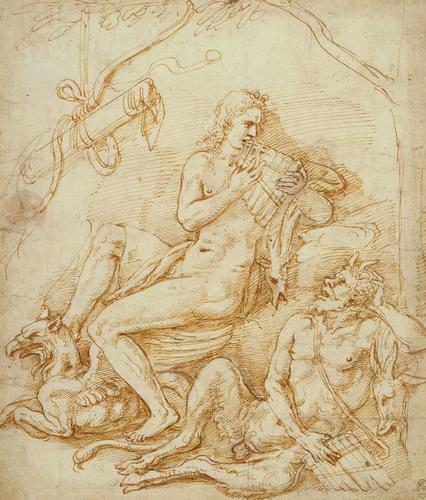Apollo and Pan (?) c.1535
Pen and ink over black chalk underdrawing; the figure of Pan squared in charcoal. Watermark of an anchor in a circle, cut | 23.2 x 19.8 cm (sheet of paper) | RCIN 990495
-
A drawing of Apollo playing the pipes, with a gryphon at his feet. The recumbent figure of Pan looks up at him, with pipes at his side.
This is Giulio at his most characteristic, with strong contours and a bold sense of flat pattern, and careless passages (the left arm of Apollo) alongside brilliant details such as the head of the gryphon or the legs of Pan. The precise subject has not been determined, for it is unusual to find Apollo playing the pipes rather than the lyre, and no final composition of this subject by Giulio is known. There is no connection between this drawing and the Contest of Apollo and Pan in the Camera di Ovidio of Palazzo Te, Mantua (for which there is a cartoon in the Albertina, Birke & Kertesz 14192), nor with another drawing of the subject at Chatsworth (Jaffé 220). The roughly circular form of the composition might suggest a connection with the small tondi of satyric subjects found in several places in Palazzo Te, but no similar composition can be found there.
Frederick Hartt (Giulio Romano, 1958, no. 239) identified the subject of both this drawing and the Camera di Ovidio painting as Apollo and Marsyas, though the same objection about Apollo's instrument applies, and Ovid did not describe the contest between Apollo and Marsyas, only its grisly result. Hartt also connected the sheet with a stylistically identical drawing of Hercules resting, formerly in the Ellesmere Collection (sale, Sotheby’s 1972, no. 52) and now in the Getty Museum. Noting the emphasis on the contours and the casting of shadows onto a flat background, he suggested that both might be studies for stuccoes on the walls surrounding a hanging garden in the grounds of the Palazzo Ducale, Mantua, on the site of the present Cortile dei Cani. That garden disappeared in the reconstructions of Duke Guglielmo in the latter half of the sixteenth century and no visual record of its form survives. A suggested association of the Getty Hercules with a putative project for Ercole d'Este is probably ruled out by the present drawing, which must be en suite and has no Herculean connection.
The Getty drawing is blackened on the verso and indented, and thus Stock (in the 1972 Sotheby’s sale catalogue) suggested that it was a study for an unexecuted print. The squaring of the figure of Pan here would also support the proposal that both were studies for some two-dimensional context. However such mechanical methods could simply be a stage in the preparatory process and need not reflect the final transfer to a support.
There are copies of the drawing in the Louvre (inv. 32567; Rosenberg & Prat, Dessins de Poussin, 1994, no. R836) and, from the workshop of Jacopo Strada, in the Österreichische Nationalbibliothek, Vienna (Cod. Min. 21, III, f.8).Provenance
Probably Royal Collection by 1800, but not identified in George III's 'Inventory A' of c.1810
-
Creator(s)
-
Medium and techniques
Pen and ink over black chalk underdrawing; the figure of Pan squared in charcoal. Watermark of an anchor in a circle, cut
Measurements
23.2 x 19.8 cm (sheet of paper)
Markings
watermark: anchor in circle, cut











